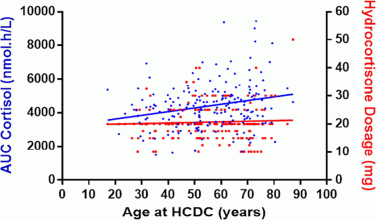SFEBES2017 Poster Presentations Adrenal and Steroids (33 abstracts)
Does cortisol exposure from the Hydrocortisone day curve predict mortality, type II Diabetes or lipid profiles?
Vishnou Mourougavelou 1 , Sirazum Choudhury 1, , Tricia Tan 1, , Jamshid Alaghband-Zadeh 1, , Emma Bodenham 1, , Karim Meeran 1, & Jaimini Cegla 1,
1Imperial College London, London, UK; 2Imperial College Healthcare NHS Trust, London, UK.
Background: Hydrocortisone day curves (HCDCs) are commonly used to assess hydrocortisone replacement for patients with adrenal insufficiency (AI).
Methods: HCDCs were obtained for 216 adrenally insufficient patients between 2004 and 2012 at Imperial College Healthcare NHS Trust. The area under the curve (AUC) was calculated for each patient’s day profile. Lipid profiles and glycated haemoglobin (HbA1c) values were recorded for each patient at both the time of the HCDC and after 5 years.
Results: The highest AUC tertile group were significantly older than the other groups (P<0.01). There was a significant positive correlation between the AUC cortisol and the age at the time of the HCDC (r(s)=0.22, P=0.001), but no significant correlation between age and the cumulative hydrocortisone dose (r(s)=−0.02, P=0.73). This suggests that we prescribe the same dose of hydrocortisone regardless of age, but these same doses achieve different AUCs depending on age. The group with the highest AUC cortisol had the poorest survival outcomes, with a 79.4% survival rate after five years (compared to 96.8% in the lowest AUC tertile (P<0.01). The HbA1c taken after five years did not significantly correlate with the AUC cortisol. (r(s)=−0.08, P=0.45, n=88). There was also no significant correlation between the AUC cortisol and total serum cholesterol at baseline (r(s)=0.12, P=0.26, n=93) or after 5 years (r(s)=−0.17, P=0.11, n=92).
Conclusions: This study found that older patients have higher AUC cortisol values. There was also no significant correlation between age and the hydrocortisone dose, which suggests that the higher cortisol exposure must be caused by a decline in the rate of cortisol metabolism and urinary excretion. The AUC cortisol was not associated with increased HbA1c levels or poorer lipid profiles, at baseline or after five years. A longer follow-up period is needed to fully assess the effect of increased cortisol exposure.




